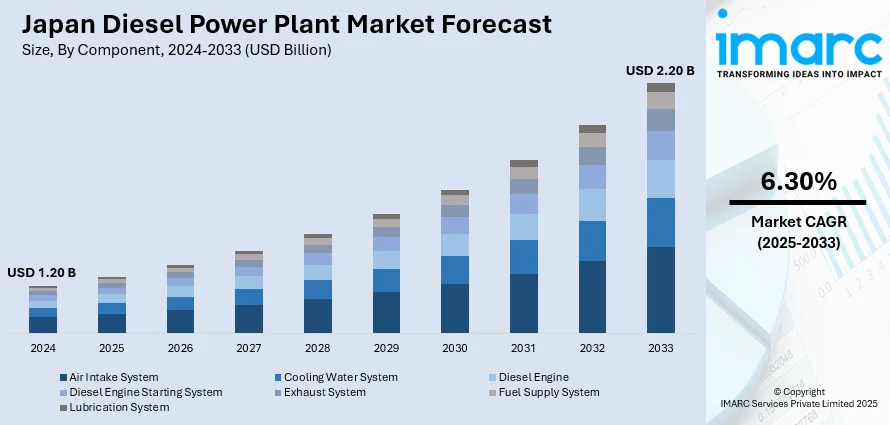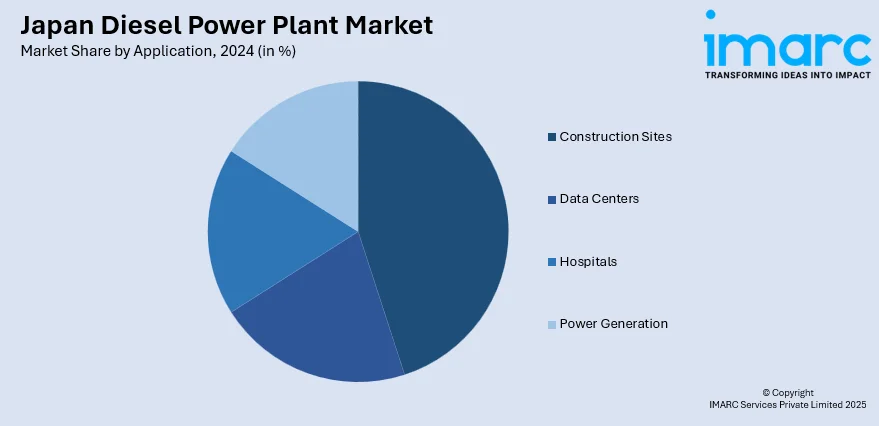
Japan Diesel Power Plant Market Size, Share, Trends and Forecast by Component, Capacity Range, Application, and Region, 2025-2033
Japan Diesel Power Plant Market Overview:
The Japan diesel power plant market size reached USD 1.20 Billion in 2024. Looking forward, IMARC Group expects the market to reach USD 2.20 Billion by 2033, exhibiting a growth rate (CAGR) of 6.30% during 2025-2033. The market is witnessing significant growth driven by the need for reliable power generation, especially in remote and industrial areas. Diesel plants offering flexibility, quick deployment, and efficiency also makes diesel power plants crucial for backup power and primary generation. The expanding infrastructure further escalates the demand for diesel power plants, contributing to the growth of the Japan diesel power plant market share.
|
Report Attribute
|
Key Statistics
|
|---|---|
|
Base Year
|
2024
|
|
Forecast Years
|
2025-2033
|
|
Historical Years
|
2019-2024
|
| Market Size in 2024 | USD 1.20 Billion |
| Market Forecast in 2033 | USD 2.20 Billion |
| Market Growth Rate 2025-2033 | 6.30% |
Japan Diesel Power Plant Market Trends:
Shift to Hybrid Systems
The use of hybrid power systems, which pair diesel plants with alternative sources like solar or wind energy, is becoming increasingly popular in the market for diesel power plants in Japan. The hybrid approach improves the power generation's efficiency and sustainability while making energy supply more flexible and stable. Through the addition of renewable power, hybrid systems can save fuel, decrease operational expenses, and minimize environmental footprints while still maintaining the reliability provided by diesel power plants. This is most advantageous for territories with unreliable grid stability or remote areas where uninterruptible power supply is the key. Hybrid systems also allow for smoother transition to cleaner energy by offsetting the patchy nature of renewables with the steady power output of diesel generators. As Japan moves ahead in emphasizing clean energy, hybrid power systems present a pragmatic solution towards achieving economic and environmental objectives.

Growing Emphasis on Emission Control
As environmental regulations in Japan become stricter, more attention is being placed on lowering emissions from diesel power plants. To meet tighter regulations, new diesel technologies and exhaust after-treatment systems, including selective catalytic reduction (SCR) and diesel particulate filters (DPF), are being installed in current and upcoming plants. The technologies lower nitrogen oxide (NOx) and particulate matter emissions significantly, making the air cleaner and overall plant operation more efficient. Additionally, there is a push towards adopting low-sulfur fuels to further minimize harmful emissions. The move toward emission control not only helps Japan meet its environmental targets but also boosts the sustainability of diesel power generation. With these advancements, diesel power plants are becoming more environmentally friendly, thereby fostering the growth of the Japan diesel power plant market growth as the demand for cleaner, more efficient energy solutions rises.
Technological Advancements
Technological advancements in diesel engine design are playing a crucial role in enhancing the efficiency and durability of Japan's diesel power plants. Modern diesel engines are now more fuel-efficient, enabling plants to generate power at a lower cost while minimizing environmental impact. These engines are also built to withstand higher operational stresses, improving their lifespan and reducing maintenance needs. Additionally, innovations such as digital monitoring systems allow for real-time performance tracking, predictive maintenance, and optimization of engine performance, further improving reliability and reducing downtime. The incorporation of advanced materials and components in engine design ensures that power plants can operate efficiently under various conditions, contributing to long-term cost savings. As a result, these technological advancements not only make diesel power generation more competitive but also position it as a reliable solution in Japan’s energy mix, boosting operational efficiency across the market.
Japan Diesel Power Plant Market Segmentation:
IMARC Group provides an analysis of the key trends in each segment of the market, along with forecasts at the country and regional levels for 2025-2033. Our report has categorized the market based on component, capacity range, and application.
Component Insights:
- Air Intake System
- Cooling Water System
- Diesel Engine
- Diesel Engine Starting System
- Exhaust System
- Fuel Supply System
- Lubrication System
The report has provided a detailed breakup and analysis of the market based on the component. This includes air intake system, cooling water system, diesel engine, diesel engine starting system, exhaust system, fuel supply system, and lubrication system.
Capacity Range Insights:
- Large Scale
- Medium Scale
- Small Scale
A detailed breakup and analysis of the market based on the capacity range have also been provided in the report. This includes large scale, medium scale, and small scale.
Application Insights:

- Construction Sites
- Data Centers
- Hospitals
- Power Generation
A detailed breakup and analysis of the market based on the application have also been provided in the report. This includes construction sites, data centers, hospitals, and power generation.
Regional Insights:
- Kanto Region
- Kansai/Kinki Region
- Central/Chubu Region
- Kyushu-Okinawa Region
- Tohoku Region
- Chugoku Region
- Hokkaido Region
- Shikoku Region
The report has also provided a comprehensive analysis of all the major regional markets, which include Kanto Region, Kansai/Kinki Region, Central/Chubu Region, Kyushu-Okinawa Region, Tohoku Region, Chugoku Region, Hokkaido Region, and Shikoku Region.
Competitive Landscape:
The market research report has also provided a comprehensive analysis of the competitive landscape. Competitive analysis such as market structure, key player positioning, top winning strategies, competitive dashboard, and company evaluation quadrant has been covered in the report. Also, detailed profiles of all major companies have been provided.
Japan Diesel Power Plant Market Report Coverage:
| Report Features | Details |
|---|---|
| Base Year of the Analysis | 2024 |
| Historical Period | 2019-2024 |
| Forecast Period | 2025-2033 |
| Units | Billion USD |
| Scope of the Report |
Exploration of Historical Trends and Market Outlook, Industry Catalysts and Challenges, Segment-Wise Historical and Future Market Assessment:
|
| Components Covered | Air Intake System, Cooling Water System, Diesel Engine, Diesel Engine Starting System, Exhaust System, Fuel Supply System, Lubrication System |
| Capacity Ranges Covered | Large Scale, Medium Scale, Small Scale |
| Applications Covered | Construction Sites, Data Centers, Hospitals, Power Generation |
| Regions Covered | Kanto Region, Kansai/Kinki Region, Central/Chubu Region, Kyushu-Okinawa Region, Tohoku Region, Chugoku Region, Hokkaido Region, Shikoku Region |
| Customization Scope | 10% Free Customization |
| Post-Sale Analyst Support | 10-12 Weeks |
| Delivery Format | PDF and Excel through Email (We can also provide the editable version of the report in PPT/Word format on special request) |
Key Questions Answered in This Report:
- How has the Japan diesel power plant market performed so far and how will it perform in the coming years?
- What is the breakup of the Japan diesel power plant market on the basis of component?
- What is the breakup of the Japan diesel power plant market on the basis of capacity range?
- What is the breakup of the Japan diesel power plant market on the basis of application?
- What is the breakup of the Japan diesel power plant market on the basis of region?
- What are the various stages in the value chain of the Japan diesel power plant market?
- What are the key driving factors and challenges in the Japan diesel power plant?
- What is the structure of the Japan diesel power plant market and who are the key players?
- What is the degree of competition in the Japan diesel power plant market?
Key Benefits for Stakeholders:
- IMARC’s industry report offers a comprehensive quantitative analysis of various market segments, historical and current market trends, market forecasts, and dynamics of the Japan diesel power plant market from 2019-2033.
- The research report provides the latest information on the market drivers, challenges, and opportunities in the Japan diesel power plant market.
- Porter's five forces analysis assist stakeholders in assessing the impact of new entrants, competitive rivalry, supplier power, buyer power, and the threat of substitution. It helps stakeholders to analyze the level of competition within the Japan diesel power plant industry and its attractiveness.
- Competitive landscape allows stakeholders to understand their competitive environment and provides an insight into the current positions of key players in the market.
Need more help?
- Speak to our experienced analysts for insights on the current market scenarios.
- Include additional segments and countries to customize the report as per your requirement.
- Gain an unparalleled competitive advantage in your domain by understanding how to utilize the report and positively impacting your operations and revenue.
- For further assistance, please connect with our analysts.
 Request Customization
Request Customization
 Speak to an Analyst
Speak to an Analyst
 Request Brochure
Request Brochure
 Inquire Before Buying
Inquire Before Buying




.webp)




.webp)












